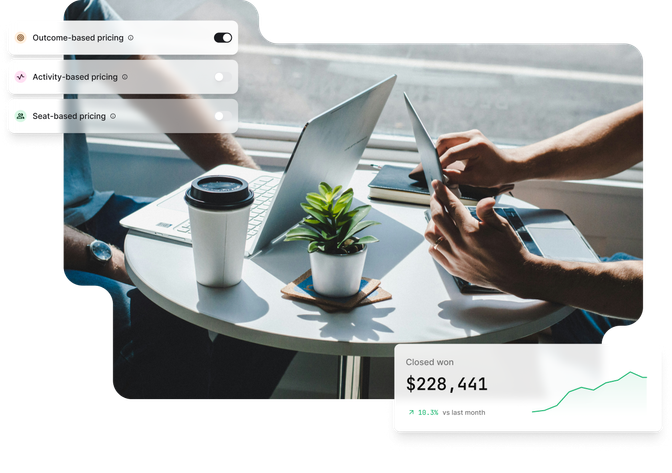Build agents, get paid
Understand your margins and get paid for the value your agents create.



Modern AI-powered HR technology companies are embedding more than just AI - but rather AI agents into compensation workflows. These agents analyze pay equity, generate offer recommendations, and help companies make smarter hiring decisions. The technology works.
The challenge isn't just in the tech, but in how it delivers the value and how that's proven to customers.
When you're selling AI-powered compensation tools to enterprises, "our platform saves time" doesn't close deals anymore.
Our experience with CFOs is that they want ROI numbers. HR leaders need budget justification, and of course Legal and Compliance teams want compliance accountability. You need to show value in terms your customers already measure.
This creates a billing problem traditional HR software never faced.
Most HR tech companies still use seat-based pricing models inherited from legacy HRIS systems. You charge per user or per employee in the system. This made sense when software sat idle until someone clicked a button.
AI compensation agents don't work that way.
Your agent might analyze 50 candidates per day for a single recruiter. It checks market data, reviews internal pay bands, flags equity issues, and generates recommendations continuously. The work happens automatically. The value compounds.
But your billing system treats all of this like a single seat license.
This disconnect creates three problems:
Standard billing platforms can't solve these problems because they weren't built for products that deliver autonomous outcomes.
HR tech companies moving to AI-based compensation intelligence need three capabilities their current billing stack doesn't provide:
Companies building AI-powered compensation tools are solving this with signal-based infrastructure instead of usage-based billing.
Here's how it works:
Traditional HR metrics | How they translate to agentic signals | Business impact to demonstrate ("ROI") |
|---|---|---|
Time to hire | Offers generated per day | Faster hiring cycles |
Pay equity compliance | Equity gaps prevented | Reduced legal risk |
Offer acceptance rate | Recommendations accepted | Better talent retention |
Manual analysis time | Hours saved per decision | Lower operational costs |
One compensation intelligence platform embedded an AI agent that helps recruiters make offer decisions. The agent analyzes candidate profiles, checks internal pay ranges, reviews market data, ensures equity compliance, and generates recommendations in real time.
They integrated an AI billing platform using OpenTelemetry. The setup took days. The system automatically captured traces from the agent's workflows.
Here's what they tracked:
Efficiency metrics: Time to generate offer, number of scenarios analyzed, decisions per recruiter per day
Cost avoidance metrics: Pay equity gaps prevented, compliance violations avoided, offer rejections reduced
Trust indicators: Recommendations accepted vs. modified, time spent reviewing suggestions
The classification engine tagged about 70-80% of signals automatically. Their team refined the rest, mapping specific workflows to business outcomes their customers measured.
The key innovation we've seen was connecting the AI agent's value to their existing pay equity product data - when their analytics showed a customer saved $500,000 in pay inflation, and that customer used the AI for 1,000 decisions, they could attribute value directly. ROI became measurable in dollars, not engagement scores.
Three things changed:
Traditional seat-based pricing doesn't match how compensation AI actually delivers value.
Three models work better:
Model | Structure | Best for | Example |
|---|---|---|---|
Hybrid | Base fee + outcome fees | Companies testing AI pricing | $5K/month + $50 per analysis |
Value-based tiers | Different prices per outcome type | Multiple distinct workflows | $100/offer, $500/equity analysis |
Outcome-based with caps | % of savings with min/max | Measurable cost avoidance | 5% of savings, $10K-$100K/month |
The best pricing strategy depends on what you can measure reliably and what your customers already track.
If your platform connects to existing HR analytics, outcome-based pricing becomes feasible.
If not, start with hybrid models and evolve as your measurement improves.
Most billing platforms and metering solutions used by HR technology companies were built for traditional SaaS or lean heavily on "credits". They handle seats, usage tiers, and subscription management well, but they can't track what an AI agent does. They can't measure the value a compensation workflow delivers. They can't price based on outcomes because they weren't designed for products that deliver outcomes autonomously.
If you're bulding AI-powered HR tools, you need different infrastructure:

If you're building AI-powered compensation technology, you face a measurement challenge that becomes a pricing challenge that becomes a growth challenge.
Your agent delivers real value. You need to prove it, price for it, and show it continuously to customers.
Three steps forward:
Don't stick with seat-based pricing, you'll struggle to justify their value as costs scale with usage.
Building AI for HR and compensation? Learn how AI-native billing infrastructure helps you track costs, prove ROI, and move to outcome-based pricing. Book a demo with Paid's pricing experts to discuss your specific needs.
Understand your margins and get paid for the value your agents create.




Price smarter. Protect margins. Grow revenue.